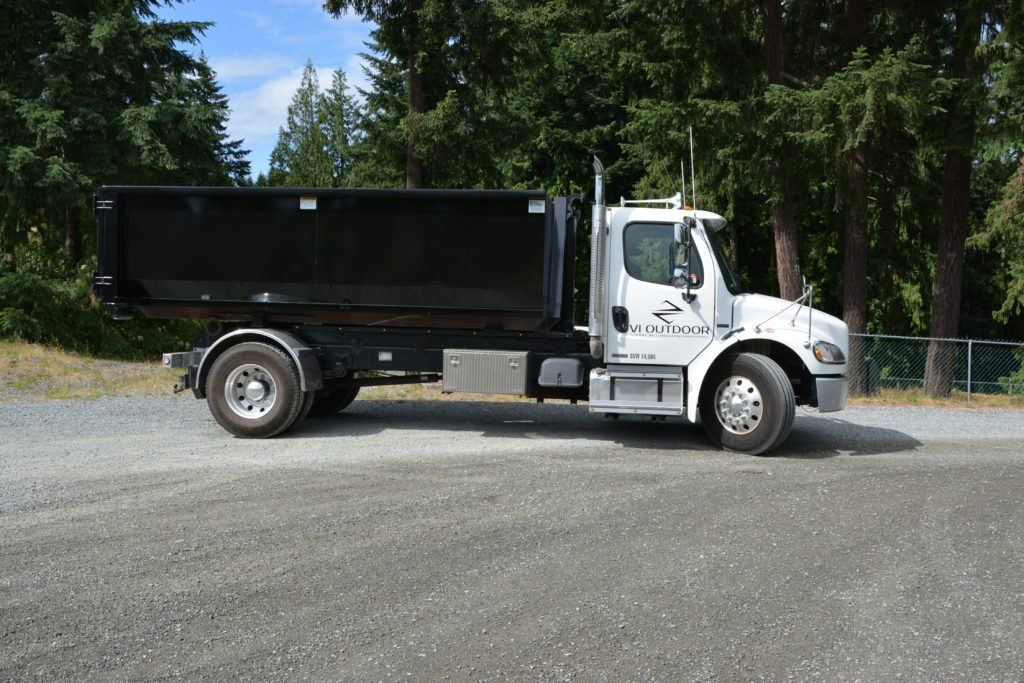We manufacture roll off containers for every size of vehicle and loading system. The typical sizes for roll off containers range anywhere from 5 to 50 cubic yards in capacity. Container sizing and fit is unique to the varying styles of lift systems that are installed on your truck with each manufacturer having recommended specifications for their hook lift systems.
In order to find the perfect sized bin to fit on your truck we will ask for the following information to ensure a seamless fit and to confirm the container is designed for the purpose you have in mind:
- Do you have a hook lift system or Cable pull type system on your truck?
- What is the make and model of the lift system is installed on your truck?
- If you have a hook lift system what is the hook height of your lift system? Standard heights for almost all manufacturers are 36”, 54” and 62”.
- The correct lengths of containers a lift system can handle are determined from the manufacturer’s specifications.
- What types of materials would you like to haul with your truck?
What Is A Cubic Yard?
A cubic yard is an Imperial unit of volume, used in the United States, Canada, and the UK. It is defined as the volume of a cube with each side being 1 yard (3 feet, 36 inches, 0.9144 meters) in length.
If we have the dimensions of a roll off container in feet, we can then calculate the number of cubic yards the container will hold. The formula is quite simple, all you need to do is follow these two steps:
- Multiply length X width X height in feet to get total cubic feet
- Divide total cubic feet by 27 to get number of cubic yards
Roll off containers are typically measured from the outside of the container using the imperial unit, feet. The formula shown above will over estimate cubic yards slightly if you use the exterior dimensions of the container. To get an accurate interior volume, make sure to measure the inside dimensions leaving out the thickness of the containers walls.
What Type Of Lift System Do I Have?
There are two main types of lift systems used in North America, Hooklift and Cable Pull Systems. Popular lift system brands include Swap Loader, Ampliroll, Stellar, MultiLift & Palfinger. Each lift system is slightly different which means that your bin will have to be made to meet the manufacturers specification to ensure that it will work seamlessly with your lift set up. The easiest way to determine the type of lift system you have is to talk with your truck dealer, consult with your owner’s manual or look for the make, model and serial number usually located on an attached plate on the lift system itself.
What Is The Capacity Of Your Lift System?
The capacity of your lift system is very important because it will determine the safe maximum weight you will be able to lift. To determine the lifting capacity of your hooklift or cable pull system, please talk with your truck dealer or consult with your owner’s manual. Alternatively, look for the make, model and serial number located on the lift system itself and contact us with those details. When determining the overall lift capacity required, make sure to account for the weight of the bin plus the weight of materials you would like to haul.
What Is The Length Capacity Of Your Lift System?
The length capacity of your lift system is another important metric because it will determine the range of length of a container that will fit on your system. The container lengths your hooklift or cable pull will accept is determined by the manufacturer of the system. Please talk with your truck dealer or consult with your owner’s manual for more information. Alternatively, look for the make, model and serial number located on the lift system itself and contact us with those details and we will be happy to help you determine the right sizes. The manufacturer of your lift system provides both minimum and maximum lengths of containers your system will be able to accommodate.
What Is The GVWR Of Your Truck?
The Gross Vehicle Weight Rating (GVWR) is the maximum operating weight/mass of a vehicle as specified by the manufacturer including the vehicle’s chassis, body, engine, engine fluids, fuel, accessories, driver, passengers bin and cargo but excluding that of any trailers. To determine your trucks GVWR please consult with your owner’s manual or truck dealer. Trucks with more than one rear axle will have a higher GVWR than those with a single rear axle. If you are planning to haul heavy loads it is recommended to have a truck with more than one axle. Please consult with your local truck dealer prior to purchasing a bin to ensure that your truck will have a large enough capacity for the materials you are intending to haul.
What Types Of Materials Will You Be Hauling In Your Truck?
Material weight can have a substantially different weight rating per cubic foot, this will help determine what type of bin you will need for your truck. For example a bin full of household waste vs a bin full of water will have a substantially different weight due to the differentiating densities. When hauling heavier materials like rocks, gravel, concrete and steel you will want to consider beefing up the container to provide years of service. Heavier walls floors and structural components can be added to the build to produce a container that will perform for years in these heavy duty applications. Your cargo weight will help determine what type of GVWR you require for your truck as well as your lift system capacity and roll off container type. If you would like to learn more about material weight densities please read our article on What Does My Load Weigh?
If you have any questions regarding roll off bin sizing for your truck please do not hesitate to contact us. We can be reached toll free at 1-877-727-7833

